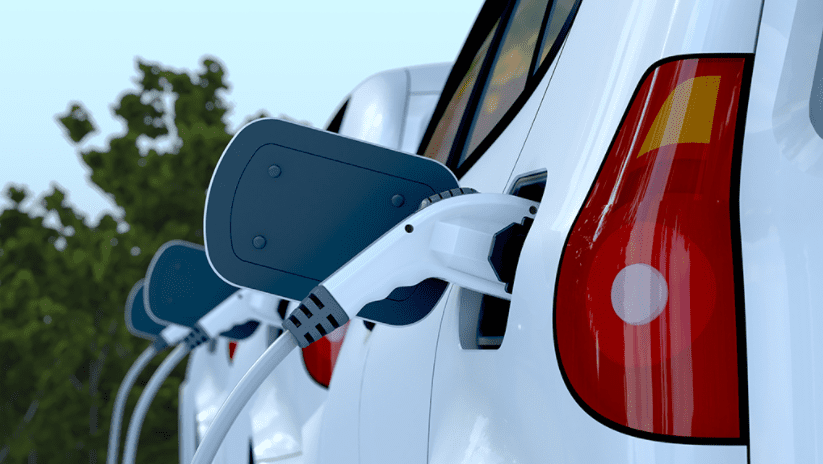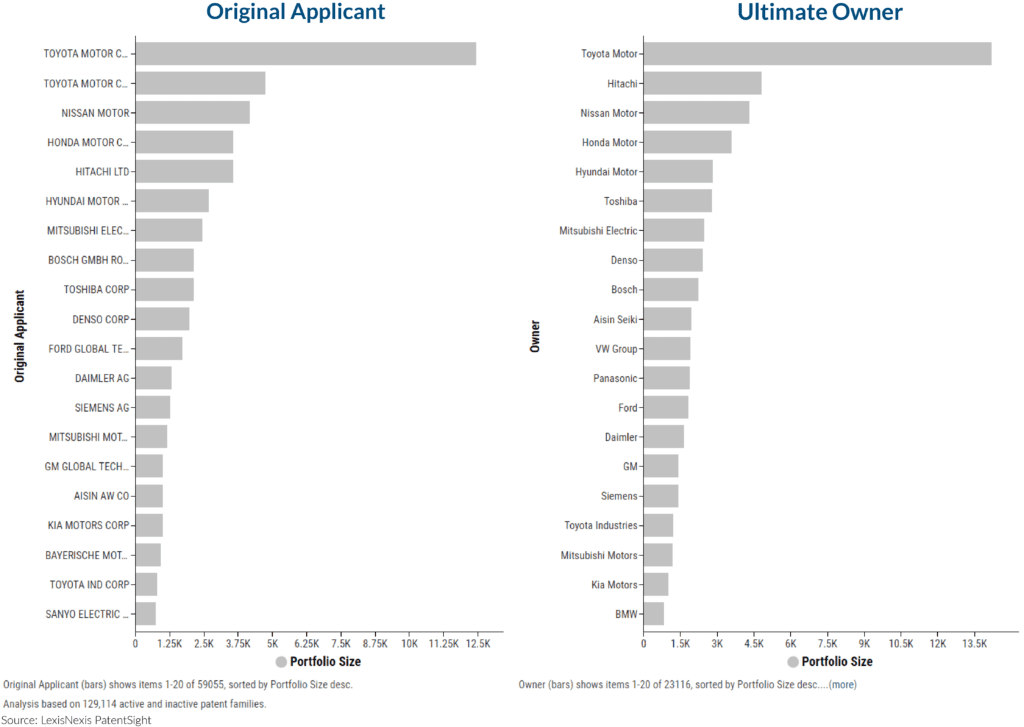e-Mobility Technology – Who’s Making It vs. Who’s Buying It?

Sarbani Chattopadhyah
10/30/2019
Last week, we kicked off our automotive Industry updates with a bird’s eye view of the technology field of e-Mobility, focusing mainly on portfolio development in this field over the last few decades. This week, in e-Mobility updates, the LexisNexis® PatentSight® team brings you a comparative view of the top 20 patent owners in the field, with a twist.
The twist in this case being, we compared the list of top 20 current “ultimate owners” of patents in e-Mobility with the original applicants of these patents. If you are unfamiliar with the PatentSight Ultimate Owner concept, please scroll to the bottom of the page for a brief description of our unique system of ownership matching. With this concept in mind, what the chart below shows is a comparison of all the companies who actually worked on these inventions and subsequently filed for patents protecting them, with respect to the companies that currently own the said patents.
Why you should care about knowing the current Ultimate Owner of patents?
Having the ability to differentiate between current owners and original applicants provides management teams a great deal of insight into a company’s strategy. Be it for decisions about make/license or entering a new market or venturing into a new technology field or any of the other million strategic decisions that an OEM has to make to remain competitive in this perennially evolving market. It is imperative for effective decision making to possess as much accurate information as possible. And when it comes to competitive insights about a technology space, there is no better source of information than patent data. Since it, conveniently, contains details of the technology protected and information about the company or individual who filed for protection, when accurately analyzed this can provide decision makers a detailed and otherwise unseen view of the playing field.
Who is buying the technology and who is developing it in-house?
This is clearly visible in the chart below, which we pulled from our Business Intelligence tool. The graph on the left shows top 20 (by volume) original applicants of patents protecting inventions in e-Mobility technology. On the other hand, the graph on the right lists out the top 20 (by volume) “current owners” of patents in the same technology field.
Here, for e.g. the Volkswagen group (VW) does not appear in the list of top 20 original applicants in the field of e-Mobility. At the same time, VW is listed among the top 20 Patent owners in the field, owning about 1900 patents in e-Mobility. In order to further inspect this, using ‘Owner’ as an added filter in our search, we took a look at VW’s portfolio in e-Mobility patents, specifically. We found that Audi and VW, together, originally filed for about 1000+ patents. The remaining may have come from acquisitions or patent purchases.

How Automotive OEMs can improve their competitive stance using PatentSight’s unique services?
One of the major advantages of performing such analyses on PatentSight’s database is our fully harmonized patent ownership data combined with accurate historical information. This allows for users to effortlessly unearth historical positions of companies and figure out technological trend shifts within any firms’ portfolio. In other words, you can identify which of your competitors have been filing for patents heavily in a specific technology field or if they are getting a head start in an up and coming technology field through acquisitions or patent purchases, since we assign each patent family to its current ultimate owner.
Definition of PatentSight’s Ultimate Owner concept:
When conducting strategic analysis, it is important to have a clear understanding of the current ownership of those patents being assessed. If you are not aware of a patent’s ultimate owner, your efforts at addressing your competition would go to waste simply because it would be focused on the wrong target. We realized, early on, that searching for just an assignee name and its synonyms are not enough to paint a complete picture of all the patents under the control of a single entity. It requires a more holistic understanding of the history and the current makeup of the entity, to be as accurate as possible. This is why our Harmonization team, of expert researchers, pour over millions of documents every week to accurately determine:
- Corporate structures: looking at subsidiaries and sister concerns
- Previous company names: the applicant name given to the patent office at the time of filing may not exist anymore
- Mergers & Acquisitions: the patent may now be owned by another entity due to a corporate merger or acquisition
- Patent transactions: individual patents being sold to another entity
- Misspellings: it occurs more often than many realize, but frequently official records are riddled with misspellings of assignee’s
- Recognition of homonyms: names used by multiple distinct companies, such as e.g. Merck
Access all of the articles in our e-mobility series:
- e-Mobility – Watch Out Traditional OEM’s!
- e-Mobility – Why is Knowing the Legal Status of Patents Important?
- e-Mobility Technology – Who Owns the Strongest Patent Portfolio?
- e-Mobility Technology – How to Predict the Portfolio of Your Competition
- e-Mobility Technology – a Final Look at the Top Patent Owners
Learn more about PatentSight.
About the author: Dr. Sarbani Chattopadhyay
As a consultant, Sarbani assists clients in using PatentSight in the most optimal way, so that they get insights about patents, about their own portfolio, and portfolios of their competitors, and technologies they are working with, as well as which other technologies are being influenced by their inventions.
